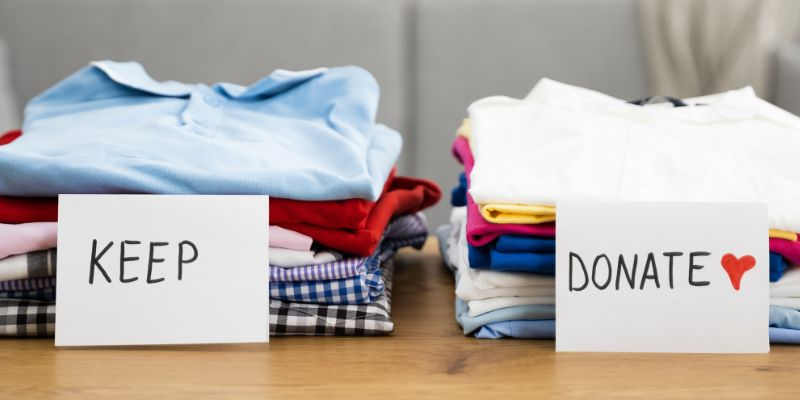The rise of thrifting: 10 top tips for shopping second hand
Before the industrial revolution in the 18th century, many people only had a handful of clothing used for necessity rather than style. People relied on mending and reusing garments until they were completely unwearable. In the mid-19th century, mass production emerged, and fashion became a phenomenon. Today, the global fashion industry is worth £2 trillion, and we consume 80 billion new pieces of clothing worldwide every year.
In fact, the fashion industry is considered the second most polluting industry in the world.
But we’re starting to come back to our roots. The alarming statistics of the fashion industry are forcing us to rethink what we buy. People were outraged at Pretty Little Thing’s Black Friday deals earlier in the month, where clothing was on sale from just 8p. People demanded to know how the brand could afford to produce the garments, pay their workers and ship the garments, all whilst making a profit.

Helpful tips on how to thrift and shop second hand
Mainstream shops bring out new collections weekly, creating immense pressure to stay up to date with the latest trends, especially for the younger generation. But this has detrimental effects on our finances, and the planet.
Thrifting has risen in popularity for good reason, it’s fun, eco-friendly and cheaper. People are keen to save their cash and help the environment – and the best bit, you can still keep up to date with the latest fashion!
It might feel like a minefield if you’re used to browsing the latest rails on the high-street so here are some top tips to help you navigate the thrifting world, whether that be through Depop, eBay, Facebook Marketplace or local charity shops.
- Research – find out the best apps and local shops to explore. Online shops like Depop and eBay are super easy to navigate if you’re after a particular garment or prefer a certain brand. You can use the filters to find exactly what you’re after, or something similar.
- Don’t be afraid to get creative – think outside of the box! If you see a garment with potential, look up ways you could up-cycle it into something new. Pinterest and YouTube have tons of tutorials to transform your wardrobe using dye, random bits of fabric and sometimes just a pair of scissors. It’s fun to think of this opportunity as a way to create a new trend – you don’t have to find inspiration from the mannequin, you can embrace your own style!
- Be patient – you’ve probably heard stories of people finding Chanel dresses and Gucci shoes, but you can’t expect to walk into a charity shop and find them waiting for you each visit. Sometimes you won’t find anything you want, but don’t be disheartened. Mainstream shops usually have whatever we want in two different colours and an array of sizes, but you’ll have to look a little harder in a second-hand shop so be prepared to spend a little more time searching than usual.
- Hunt for denim – denim has a low resale value and it’s extremely costly to the environment: 1,800 gallons of water is needed to grow enough cotton for just one pair of jeans. So buying denim second hand makes a big difference! Something to consider however, is that denim is extremely durable so are you using your current jeans to their maximum potential?
- Spot trends before – if you love staying up to date with the latest fashion then check out upcoming trends and thrift for them. After all, fashion repeats itself so you’re likely to find something older that is fashionable now!
- Discipline – just because it’s second hand doesn’t mean that it’s sustainable to buy hauls of clothes. Ask yourself how often you would truly wear a garment or if you have three similar items at home, before purchasing.
- Repair and restore – don’t be afraid to get your sewing kit out and make a few amendments.
- Have an open mind – these clothes have a story so be open to new styles. People donate clothes after a de-clutter or a change of style, they haven’t been dumped just because they’ve gone out of style. Sometimes it’s best to thrift with no particular desire in mind but rather to explore and have fun.
- Don’t forget to de-clutter too – frequently go through your wardrobe and assess ‘have I worn this in a while?’ And be honest, are you likely to wear it again? If more people share their clothes, the selection will be better. Encourage your friends, family and strangers on the internet to do the same.
- Contact the seller – if you’re buying online don’t be afraid to message the seller to find out the specifics – what’s the fit or length like? This will save you time and disappointment when it arrives.
There are multiple issues with fast fashion: 93% of brands don’t pay garment workers a living wage and they use production methods that pollute water and land. Additionally, more than $500 billion of value is lost every year due to the lack of recycling and underutilisation of clothes.
Thrifting can work to deconstruct the fashion industry for the better and using our ten tips, you won’t need to sacrifice your style, you just need to alter your consumer habits.


